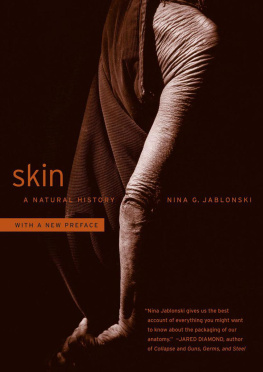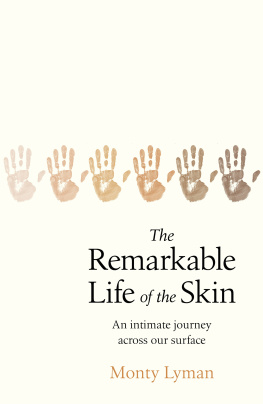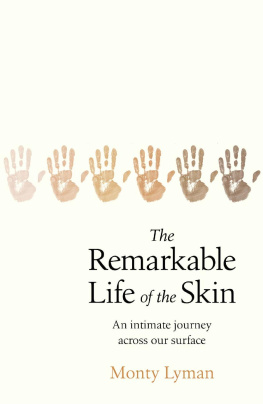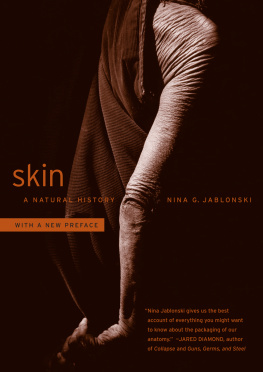skin
skin
A NATURAL HISTORY |
NINA G. JABLONSKI WITH A NEW PREFACE |  |

UNIVERSITY OF CALIFORNIA PRESS Berkeley Los Angeles London
University of California Press, one of the most distinguished university presses in the United States, enriches lives around the world by advancing scholarship in the humanities, social sciences, and natural sciences. Its activities are supported by the UC Press Foundation and by philanthropic contributions from individuals and institutions. For more information, visit www.ucpress.edu.
University of California Press
Berkeley and Los Angeles, California
University of California Press, Ltd.
London, England
2006, 2013 by Nina G. Jablonski
Title page photograph Heather Leah Kennedy
ISBN: 978-0-520-27589-8
eISBN: 9780520954816
Previous edition:
Library of Congress Cataloging-in-Publication Data
Jablonski, Nina G.
Skin: a natural history / Nina G. Jablonski.
p.cm.
Includes bibliographical references and index.
ISBN -13: 978-0-520-24281-4 (cloth: alk. paper).
ISBN-10: 0-520-24281-5 (cloth: alk. paper)
1. Skin.I. Title.
QP 88.5.1332006
612.79dc222006007731
20 19 18 17 16 15 14 13
10 9 8 7 6 5 4 3 2 1
In keeping with a commitment to support environmentally responsible and sustainable printing practices, UC Press has printed this book on Rolland Enviro100, a 100% post-consumer fiber paper that is FSC certified, deinked, processed chlorine-free, and manufactured with renewable biogas energy. It is acid-free and EcoLogo certified.
TO GEORGE
CONTENTS
ILLUSTRATIONS
Color Plates and Maps
Following chapter 5
Plates
Maps
Figures
ACKNOWLEDGMENTS
Books arise in the heart and then grow and take shape after a long gestation, nourished by conversations, research, chance encounters, contemplation, and simple toil. I first thought, many years ago, that I would write a book on skin color because I knew something about the subject and recognized its importance. After talking over the prospect of such a project with Blake Edgar, my editor at the University of California Press, I realized that a book with a wider scopethe story of skin itself, not simply skin color was clearly needed. I knew of no other work that dealt with human skin in its entirety, in the manner of an old-fashioned natural history. I have Blake to thank for many things, but foremost among them is for enticing me to broaden the scope of my original idea, thus allowing me to deepen and enrich my knowledge about one of the most important parts of the body.
The writing of this book took me to a wondrous and lurid array of places, on the ground and in cyberspace. Some of them, such as anthropology museums and human anatomy laboratories, were already very familiar to me; others, such as tattoo conventions and the Web sites of performance artists and manufacturers of implantable microchips, were refreshingly new. I had a great respect for skin when I started this work and a substantially greater measure of respect by the time I finished. Skin is not only crucial to our health; it is also an important vehicle for self-expression. The eyes may be the mirror of the soul, but the skin is the mirror of everything else.
I was able to write this book because of the support and active assistance of many people and organizations. Thanks are owed to four people in particular, without whose individual input the book would never have been completed. Blake Edgar acted as a muse and an unfaltering guide throughout the life of this project. Good editors do many things for their authors, serving alternately as psychotherapist, grammarian, content specialist, creative writing teacher, and life coach, as needed. Blake filled these varied roles effectively and effortlessly and never made me feel like an idiot even when at times I wrote and acted like one. He also enlisted four reviewers whose varied, thoughtful, and constructive comments made this book more readable, comprehensive, and approachable.
Nana Naisbitt, my friend and supporter, offered both inspiration and assistance. In her capacity as the executive director of the Pinhead Institute in Telluride, Colorado, she and her board chose me as the first Pinhead Institute Scholar in Residence in July 2005. I am grateful that I was able to write most of the first draft of my manuscript in such a beautiful place.
Bonnie Warren, my research assistant, helped me assemble and track most of the references and illustrations that appear in the book. This was a Herculean task, which required patience, perseverance, and punctilious attention to detail. Her unflappable attitude and good humor were invaluable.
George Chaplin, my husband, read the first draft of the book and offered many insightful suggestions and constructive criticisms that improved it. Conversations with him over the years have been my greatest single source of inspiration. George also provided me with just the right diet of advice, good food, cajoling, jokes, and badgering that I needed to finally get the job done. I doubt that this book could have been written without his love and enduring, steadfast support.
I received generous advice and access to useful photographic images from many colleagues and friends in the course of researching and writing. These included Robert Altaian, Mauricio Antn, Victoria Bradshaw, Alastair Carruthers, James Cleaver, Paul Ekman, Harriet Fields, David Kavanaugh, Patrick V. Kirch, Dong Lin, Kira Od, Edward S. Ross, Geerat Vermeij, and Christopher Zachary. From the library of the California Academy of Sciences, Patti Shea-Diner helped me with innumerable interlibrary loans; and Kathleen Berge and Anna Barr, of the Anthropology and Education Departments, respectively, provided generous assistance in the final stages of manuscript preparation. The excellent editorial and production staff at the University of California Press worked tirelessly to make this a readable and attractive book. My special thanks go to Dore Brown, Matthew Winfield, Nicole Hayward, and especially Mary Renaud for her superb copyediting.
Finally, I would like to thank the Fletcher Foundation for providing me with an Alphonse Fletcher Sr. Fellowship during the final months of writing this book. This financial support allowed me to include many more illustrations in the book than otherwise would have been possible. Thanks to that generous award and the research I have done in the last few years, the book on skin color that started me off on this project several years ago has been born anew in my heart.
PREFACE
Books have legs. After they are published, they enter the lives of others and are transformed. When Skin: A Natural History came out in 2006, I did not know how it would be received. Most of all I hoped that people would find it useful. Six years on, Skin is still getting under the integument of lots of people, in good and unexpected ways. There is something in here for everyone, whether you are a student interested in evolution, a tattoo enthusiast, a dermatologist, or a person who just wants to know more about skin.
Skin is an anthropological book, but not pedantically so. It looks at its subject from all conceivable human angles, beginning with its evolution. Skin as a subject attracts attention because it is something that everyone has and that most people have thought about, and it holds our interest becausein the great inventory of body partsit is more relevant to our lives as social beings than any other organ, perhaps with the exception of the eye. This book is about how skin has evolved its diverse roles as a physical and social interface and why it continues to be of fundamental importance to all of our lives.
Next page












